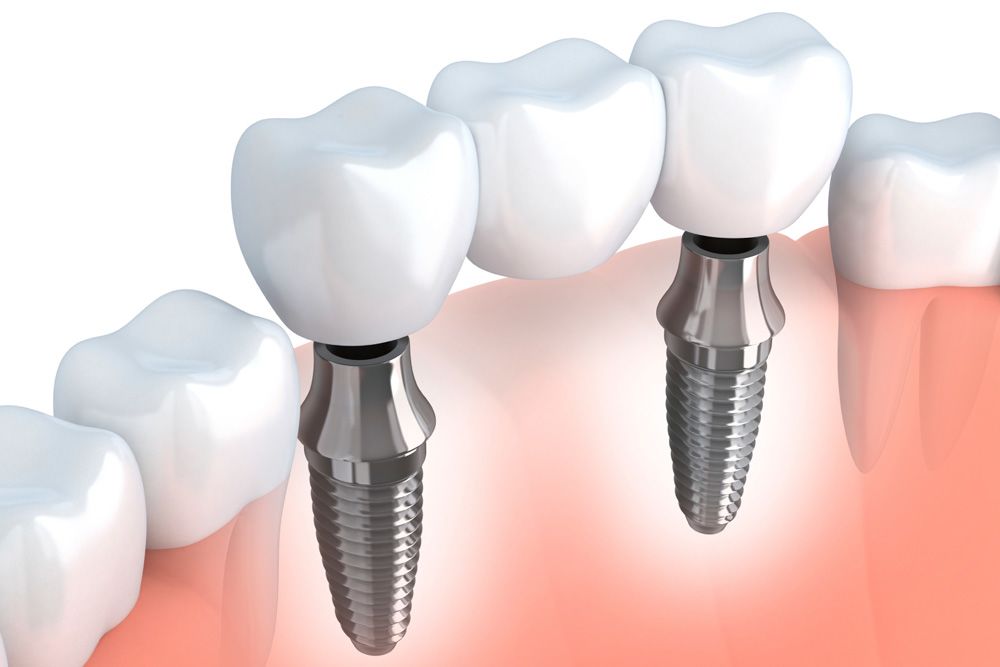Dental Implants
New Patient Experience
Only $109 – Includes all necessary X-rays and Dr. examination
Second Opinion
Considering a major dental procedure and want a second opinion? Request a complementary consultation today ($195 value).
Rebuild Your Smile with Restorative Treatments
Types of Dental Implants
Implants can be divided into several categories based on their size and shape, as well as the technique used for placement. Each smile is different, so your dentist will determine the ideal implant size for you depending on the spacing of your teeth and the quality of bone present.
Implant Shape
The shape of an implant affects its stability and long-term strength. While there are many types of implant shapes, the two most common are:
- Screw-type: This type of implant is threaded like a screw and can effectively transmit the biting force to the surrounding bone. Screw-type implants are one of the most common types of implants.
- Cylinder-form: These implants have a similar shape to screw-type implants without the threading, allowing for easier placement in the jaw. However, the smaller surface area does not provide the same level of stability as screw-type implants.
The optimal implant shape depends on where the implant is placed and the placement method used.
Placement Method
One key difference in implant types is the procedure used to place them. There are three placement methods in use today. The two-stage procedure is the most common method. First the implant is placed and allowed to heal. Then, an additional surgery is performed to uncover the implant and place the abutment (connector device) and temporary restoration.
In contrast, single-stage implants do not require the additional uncovering procedure. A healing abutment is placed at the same time as the implant post. Once the implant has healed, the final abutment and crown can be placed immediately. This placement method requires more care during the healing process, as the implant is especially vulnerable to external factors.
Immediate-loading implants are also an option for qualifying patients. Treatment involves places the implant and restoration during a single surgery. The candidacy for this type of implant is limited as patients are required to have sufficient bone density and volume.
Choosing the Right Type for You
The optimal dental implant type for you will depend on a range of factors, including the type of restoration you need and the anatomy of your jaw. For example, mini dental implants are typically used for patients with low bone density who do not qualify for bone grafting.
However, not all dentists offer mini implants. Be sure to discuss the different options available with your dentist before deciding to proceed with your implant treatment.

Benefits of Dental Implants
Lifelike Function and Appearance
Dental implants act as artificial tooth roots, allowing your implant-supported restorations to anchor into the jaw in the same way as healthy, natural teeth. This ensures your dental prosthetic will not loosen, wobble, slip, or slide out of place during biting, chewing, or speaking. Denture patients especially often find this newfound confidence to be nothing short of life-changing.
Dental implants can last a lifetime with proper care, making them a cost-effective investment in your oral health. Additionally, when fabricated from high-quality dental materials such as zirconia and IPS e.max®, artificial teeth can imitate the reflective qualities of tooth enamel. This allows your implant-retained prosthesis to look natural and blend seamlessly into your smile.
Improved Bone Health
Natural tooth roots move when we bite and chew. This motion stimulates the jaw and instructs the body to send calcium and phosphorus as nourishment to maintain dense, healthy bone tissue. This phenomenon is called the piezoelectric effect.
Conventional crowns, bridges, partials, and dentures only replace the crowns, or visible portions, of lost teeth, so the brain is not alerted to deliver essential nutrients to the jawbone. Over time, bone density decreases due to a lack of calcium and phosphorous and the jawbone deteriorates and shrinks in size. As the jaw atrophies, a sunken facial appearance known as facial collapse can occur and the reduced tissue can threaten the stability of surrounding teeth.
Since dental implants replace tooth roots, they are the only prosthetic option that creates the piezoelectric effect. For some patients, implants can not only halt bone degeneration but even encourage new tissue development in the area.
Preservation of Healthy Teeth
In addition to protecting your jawbone, implant-supported restorations also eliminate the need to remove healthy tissue from surrounding teeth. Traditional bridges require your dentist to alter the structure of supporting teeth in order to place crowns. With an implant-supported restoration, your appliance attaches to implant posts rather than dental crowns and your healthy teeth remain intact.
Experience the Advantages
Implant-supported restorations are the next best thing to having a full set of your own healthy, natural teeth. When placed by a dentist or oral surgeon skilled in implant dentistry, the treatment can improve your health and appearance, and enhance your overall quality of life. Talk to your dentist about whether this advanced treatment option is right for you.